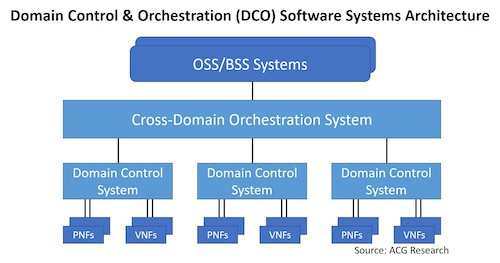Domain Controllers: Multivendor This Time?
By: Mark Mortensen

The advent of SD-WAN and SDN controllers has heralded a new era in telecom network management architecture. The old proprietary vendor-supplied element and network management systems (EMS and NMS) are being replaced by a new generation of domain control (DC) and cross-domain orchestration systems built with cloud-born software technologies. Every supplier of these systems touts their multivendor capabilities, although all but a few are difficult to interface with the multiplicity of vendors, equipment, and versions.
Domain Control Systems: a closer look
CSP networks are large and complex with multiple interworked technologies requiring multiple skill sets and tools to manage effectively, including planning, installing, analyzing, assuring and securing them. To manage and evolve their networks to meet their needs today, CSPs typically divide their deployment into domains, often by technology (such as optical transport, IP/MPLS or carrier Ethernet), by service (such as SD-WAN or residential broadband), by geography, or along organizational boundaries. A tiered management structure has evolved that seeks to automate provisioning and assurance within a domain (using domain-oriented controllers and applications) as well as across domains (using cross-domain functionality, also called orchestration software).
The need to refine and evolve these implementations is creating the new DC and cross-domain orchestration systems, progressively replacing EMS, NMS, and many OSS systems and expanding on the work begun in early-stage SDN, NFV and resource orchestration areas. The software is being brought to market in both vendor and open source initiatives. It is generally being implemented as a suite of cloud-native, model-based, API-driven, cloud-hosted modules that support the full lifecycle of operations needed within and across an operator’s domains. IM addition, it is increasingly linking northbound to higher-level service and business management systems. It is a modular tier of software that streamlines and enhances the operation of multivendor, multilayer and multidomain network infrastructures as shown in the figure.

Figure 1: Network Infrastructure
The Domain Control Systems operate on the physical network functions (PNFs) and virtual network functions (VNFs), providing overall management of the elements within their domain. Like today’s EMS systems, they provide provisioning of the network functions themselves and of the services utilizing them—but with much more automation. They also serve as telemetry conduits for performance information, like EMSs, but also analyze the information to provide network and service assurance support. Ultimately, they will provide closed-loop automation to add network resources when they detect the need.



















